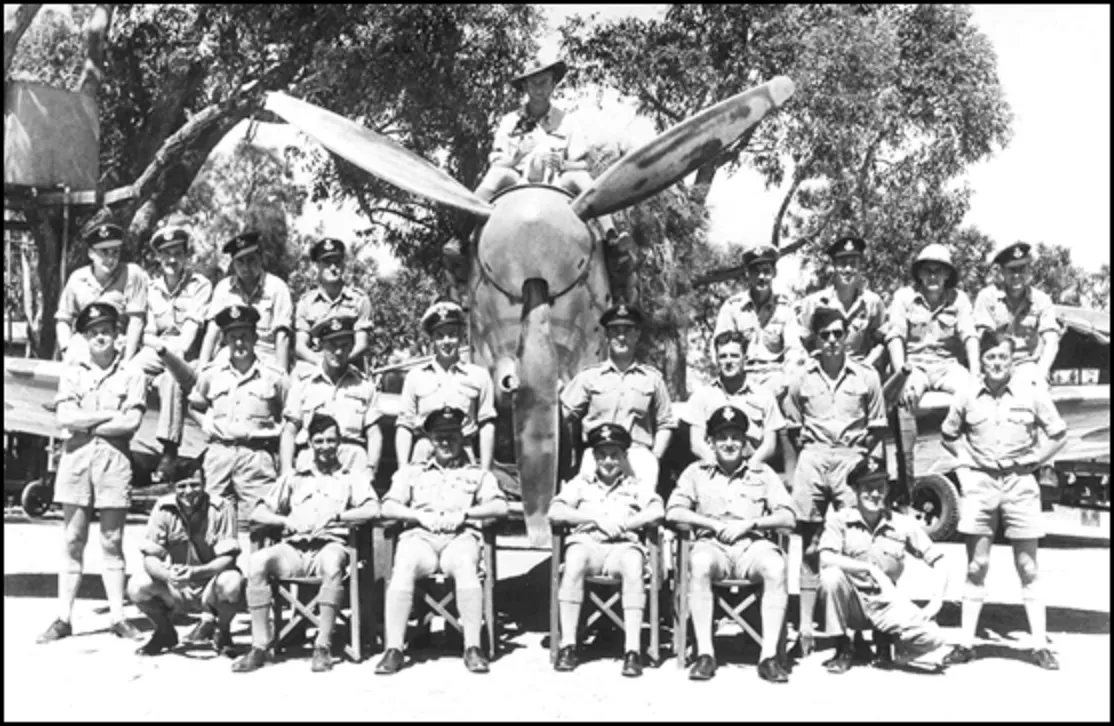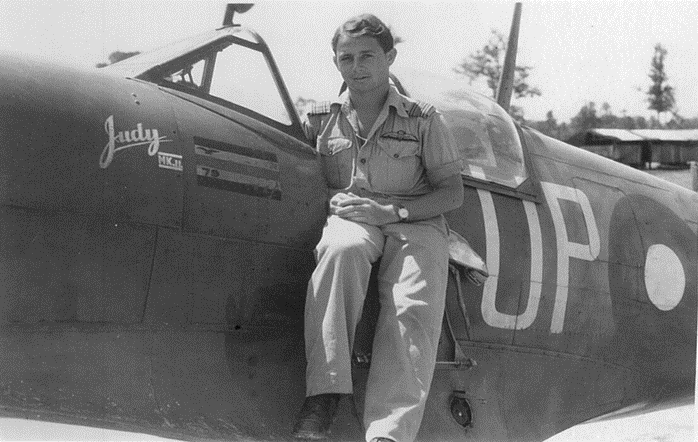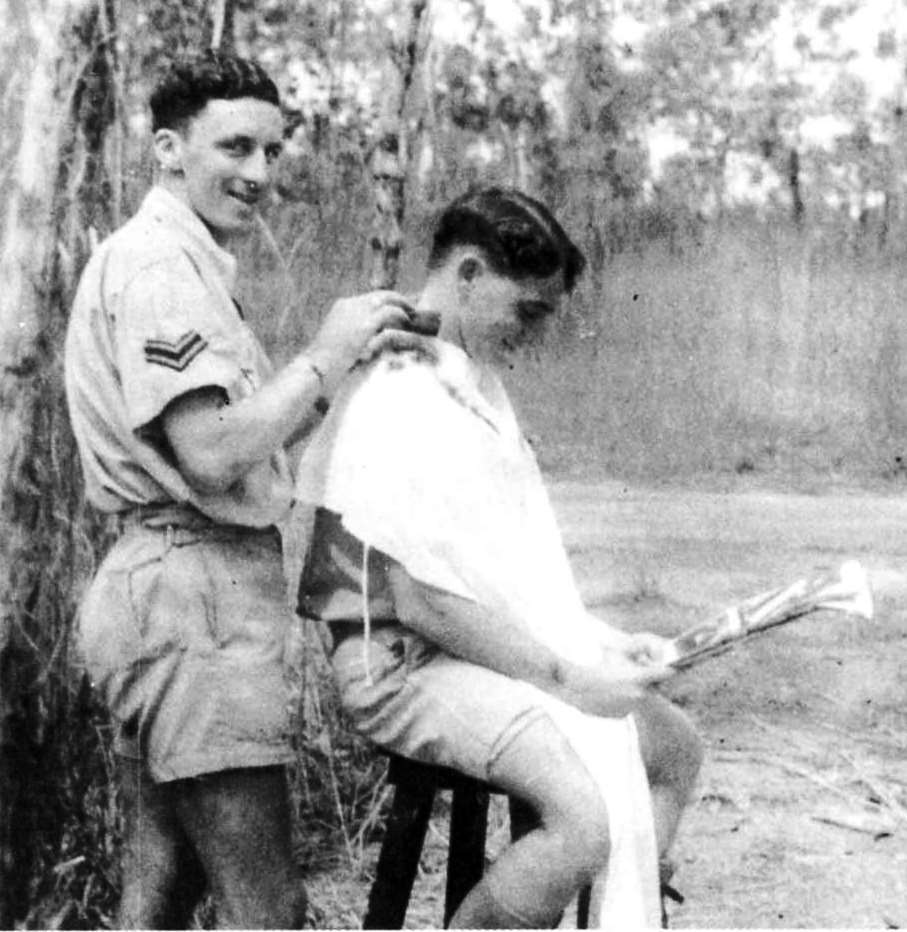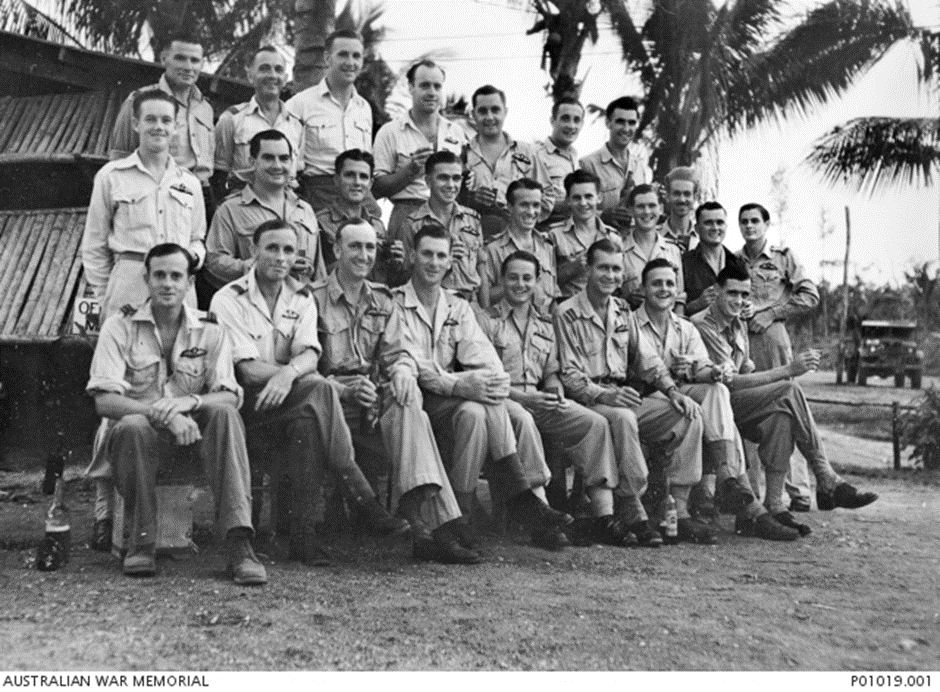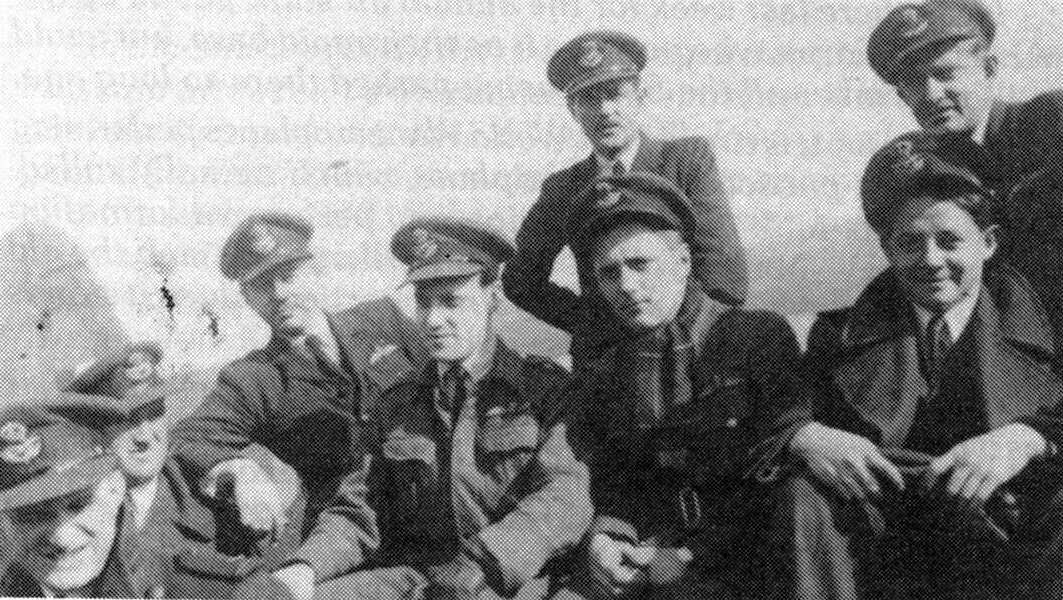SQNLDR Kenneth E James 408021
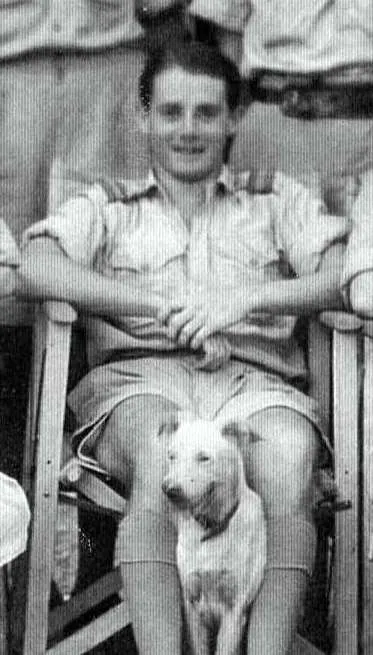


| Squadron/s | 79 SQN 85 SQN 452 SQN 457 SQN 790 SQN |
| Rank On Discharge/Death | Squadron Leader (SQNLDR) |
| Nickname | Skeeta |
| Mustering / Specialisation | Pilot |
| Date of Birth | 27 Mar 1920 |
| Date of Enlistment | 20 Jun 1940 |
| Contributing Author/s | Bill Schoon, Kinga Jurth and Bruce Read Updated by Vince Conant, Wendy James, Steve McGregor October 2013 The Spitfire Association |
Known as Skeeta, short for Mosquito, "because he was a little Lad when he were young". Skeeta was a native of Victoria, born in Ballan, Vic on 27th March 1920 and enlisted on the 20th June 1940.
As R.A.A.F. Laverton Squadron Leader Ken James reached forward and pushed the starter and booster coil buttons. As the prop started to turn, he vigorously worked the priming pump. One, two, three, four blades, the engine coughed and then with a belch of exhaust smoke burst roughly into life. Soon the Merlin settled down into its familiar rough idle and staccato crackle from the exhausts. Ken released the buttons and stowed the primer pump as the engine warmed up. All the vital signs looked good, oil pressure and temperature in the green, coolant temperature well within limits, brake pressure up to 120 psi and time for the power and magneto checks.
Ken ensured that he had two men on the tail. He then opened up to maximum boost with weak cruising fuel mixture and exercised the constant speed propeller. No problems there. He then applied full throttle and checked that he was able to attain maximum take-off power of 12 inches of boost at 3,000 rpm. Then, coming back to 7 inches of boost and 2,650 rpm, he cut each magneto in turn and observed the drop in revs. Less than 150; that's OK. As he throttled back to idle, he again checked temperatures and pressures. All were within limits. It was time to fly.
As he taxied out, Ken did his final checks. Trim, elevator one division nose down, rudder full right; flaps up; radiator shutter open; mixture rich; pitch fine. He turned on to the runway and slowly opened the throttle. Countering any tendency to swing with a boot-full of rudder, he held the Spitfire VC straight until, he gently lifted off the runway and retracted the undercarriage as the aircraft accelerated to 170 mph.
As he pulled into the climb, the thought passed through Ken James' mind that it was three months since he had last had the joy of flying a Spitfire. That had been halfway around the world in the United Kingdom, and he had been flying operations against another enemy. Now he was back in Australia to help save his homeland from the Japanese.
Bill Schoon one of Skeeters pilot mates recalls, "I wonder if Skeeter recalls our lucky find of 2 Mustangs ditched near the beach at Sangie Island (south of the Philippines). We had to destroy them, but refrained from firing at the Japs and natives, then about 2 miles away, we spotted the two yellow life rafts surrounded by native prahuas each with a Jap aboard! From 50' you could see the broad smiles of relief on the 2 USAF pilots' faces, as they were trying to hold them off with their .45's! I returned at full maximum power (240 miles) while Skeeter climbed up into the clouds, throttling back and descending to keep them guessing – eventually returning with minimum fuel having contacted a passing DC3 – my radio went on the blink, but I managed a ‘straight in' in busy Pitoe strip, and a relief section left immediately.
That night we received a signal from Zamboanga advising that a Catalina had picked them up and they were safe! Lucky indeed – for they did not share the same fate that befell 4 Kittyhawk pilots in the same area, some time previously – 3 were beheaded and the fourth paddled out to sea never to be found again!
Skeeta had three confirmed victories, one being shared with No 457 Squadron, Europe, and Darwin 1942-1943.
Spitfires were crucial to the defence of Australia during World War II. They were Darwin's guardian angels.
Few Australians have understood the beating Darwin endured. The onslaught began on February the 19th, 1942 when the aircraft carriers Akagi, Kaga, Hiryu and Soryau all of which had been in the Japanese attack on Pearl Harbour 10 weeks earlier launched 188 planes.
Another force of 54 bombers was despatched from Ambon. They pounded the town, harbour, airfield and ships with bombs and torpedoes, killing 243 people, in an attempt to render Darwin impotent as a base. Defended at first only by inadequate Wirraways, later by Kittyhawks. Darwin was bombed in 64 attacks.
The Spitfires became operational here in January 1943; unit led by Group Captain Clive Caldwell shooting down two Zeros on February 6, the first time the two types had met over Australia.
It was no fun for Air Commodore, Ken James, the first pilot to fly a Spitfire in Australia. Ken's signature is on one of the prints honouring their role in the defence of Darwin.
He shot down a German Fw190 over Europe and three Japanese Zeros over northern Australia. James said "it was our job so we did it. It all seemed so completely normal back then".
The most important single seat fighter of its era, the Spitfire achieved immortality in the Battle of Britain.
(Author of this excerpt unknown)
Skeeta succeeded R.C.H. Sly as B Flight Commander of 457 SQN between 28 April 1942 and 18 June 1942. He replaced D.H. Maclean before taking command of the unit.
A new wing, No. 1 Fighter Wing, was formed to manage the operations of the three squadrons. Group Captain A.L. 'Wally' Walters AFC, a highly respected permanent RAAF officer was appointed to command the RAAF's first fighter wing. His Wing Leader was 21.5 victory ace Wing Commander Clive R Caldwell, a much-decorated veteran of the fighting in the Western Desert. No. 452 Squadron was commanded by Squadron Leader Ray 'Throttle' Thorold-Smith, No. 457 by Squadron Leader Ken 'Skeeter' James and 54 by Squadron Leader Eric 'George' Gibbs.
On the 7th September the Japanese sent a twin engine reconnaissance aircraft heavily escorted by 21 fighters. The first warning of this reconnaissance in force came at 8.30 am when the enemy planes were 180 miles from Darwin. Twelve aircraft of No 457 were ordered to go to exit points to intercept them. Radar operators thought at first that only one aircraft was coming, but soon it was clear that many were on their way, and a total of 48 Spitfires took to the air led by Flight Lieutenant Bob Foster. While the Spitfires of Nos 54 (Candy) and 452 (Troppo) were near Port Patterson the pilots saw 21 enemy aircraft 16 miles west of Sattler and at a higher altitude. The enemy fighters attacked before these Spitfires could gain a height advantage. In the affray which followed one enemy fighter was destroyed and two probably destroyed. A Spitfire pilot, Flying Officer William Hinds, was shot down and killed, while two others, Squadron Leader Ron MacDonald, commander of No 452 (Troppo), and Pilot Officer Paul Tully, also of No 452 (Troppo) were shot down but escaped by parachute. A cannon shell from a Japanese fighter exploded in the cockpit of MacDonald's machine and he suffered serious burns before baling out. He was found later near Tumbling Waters and returned to the RAAF Medical Receiving Station in a Tiger Moth aircraft flown by Squadron Leader Fenton.
Immediately after this clash, No. 457 (Skeeter), which had been airborne earlier and had a height advantage, carried out a successful attack on the enemy aircraft, shooting down four Zekes (Zeros) and damaging others. All Spitfires from 457 (Skeeter) squadron returned undamaged to base. During this raid the Japanese used radio jamming for the first time so that the Squadron's had difficulty communicating. The ground station's radio transmitter was completely interrupted by a loud scream or whistle, which made it impossible for further orders to be passed to the aircraft. Consequently they encountered the enemy unexpectedly and in the most disadvantageous position contributing to the death of F/O Hinds. (The problem they had with the radio reception was initially thought to have been the accidental jamming down of a key in one of the Spitfires but Murimitsu Sasaki who was in one of the Ki-46 Dinah's confirmed they had dispensed thin strips of aluminium to blanket the radar. According to Bob Alford's research this was the first time over the NWA).
After his time in 457 SQN, Skeeta became Commanding Officer (CO) of No 85 Squadron RAAF, from September 1944 to March 1945, then No 790 Squadron RAAF from May 1945.
Ken was discharged on the 11th February 1946 from No 11 Group Headquarters.
Ken (Skeeta) James was also one of the members of the founding committee of the Spitfire Association, which in 2021 celebrated its 60th anniversary. A past President of the Spitfire Association and fellow pilot Lysle Roberts often laments the powers that be and their error when Skeeter James did not receive a medal for bravery and accomplishing so much. For being so young and having so much authority thrust upon him surely this will one day be redressed. We think that Skeeter James would just shrug and walk away.

